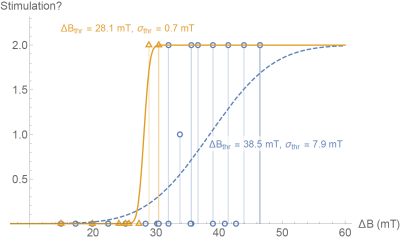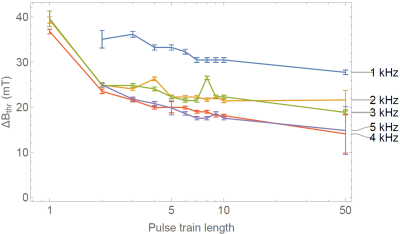2480
Peripheral Nerve Stimulation limits with fast narrow and broad-band pulses1Spanish National Research Council (CSIC), Valencia, Spain, 2Universitat Politècnica de València, Valencia, Spain, 3Tesoro Imaging S.L., Valencia, Spain
Synopsis
We present an apparatus for PNS threshold determination on a subject's limb, capable of narrow and broad-band magnetic excitation with pulse characteristic times down to 40 us. From measurements on 51 volunteers, we observe that PNS limits coincide for sinusoidal and triangular excitations, and are slightly lower for trapezoidal pulses. We measure significant correlations of PNS sensitivity with arm size and body weight, and none with height or gender. We confirm thresholds increase significantly for short trains also in these fast timescales. Finally, we propose our versatile low-cost system for fast offline determination of a subject's limits prior to scanning.
Introduction
Peripheral Nerve Stimulation (PNS, [1]) of patients is one amongst few safety concerns in clinical applications of Magnetic Resonance Imaging (MRI) and Magnetic Particle Imaging (MPI). Some of the latest and most extensive PNS threshold measurements have been performed in the field of MPI [2, 3], which makes use of narrow-band excitation pulses with frequencies in the tens of kilo-hertz. These measurements exploit the resonant nature of MPI coils to generate strong magnetic fields. However, resonant circuits also constrain the rate at which magnetic pulses can be switched, they obstruct PNS threshold measurements against relevant variables (e.g. pulse train length), and they impede the use of broad-band pulses (relevant to MRI). Besides, MPI frequencies are fast compared to typical MRI timescales. Consequently, PNS threshold measurements for broad-band pulses switched in tens to hundreds of micro-seconds are scarce, even if this fast regime may be relevant for small, dedicated MRI systems, often based on permanent magnets and where field orientations may differ with respect to conventional systems [4, 5].Methods
We have constructed an apparatus for PNS threshold determination on a subject's limb (Fig. 1a), capable of narrow and broad-band magnetic excitation with pulse characteristic times down to 40 us, and which can be configured for different spatial magnetic field strength distributions [6]. The top and bottom plates each enclose a pair of coils which can generate dynamic magnetic fields (Fig. 1b). The system can be configured to generate a rather homogeneous field strength distribution (constructive configuration), or one which varies approximately linearly along the axis (destructive configuration, Fig. 1c).In a first study, our goal is to determine magneto-stimulation thresholds for narrow and broad-band pulse trains, on a sizable population and for characteristic excitation times going from 250 down to 42 us. We ran the same protocol on 51 volunteers, following ethically approved procedures [6]. For these experiments, subjects introduced their right forearm and were first exposed to a short training session to learn their particular perception of PNS. We then ran systematic scans with trains of 1,000 pulses for three different waveforms: sinusoidal (narrow-band), and triangular and trapezoidal (broad-band) pulse shapes. For a given waveform and time configuration, we first carried out a coarse amplitude scan, which stopped once the subject reported stimulation. We then swept randomly a small region below the reported stimulation amplitude with finer resolution and including a few “placebo” (low intensity) pulses. The acquired data fit well to error functions (Fig. 2, [6]).
In a second study, we extend the above quantitative results with more qualitative observations about magneto-stimulation patterns under different circumstances: i) the influence of the pulse train length on the reported PNS threshold; ii) measurements of PNS thresholds for the constructive and destructive field configurations (Fig. 1c); and iii) the influence of the arm position on the nature and strength of the stimulation.
Results
The plots in Fig. 3 are the main result for the first set of experiments (in-depth analysis in [6]). The left plot shows the average PNS threshold for sinusoidal pulse trains as a function of their frequency. We also fit each dataset to a standard model [1] to determine a rheobase and chronaxie time for every volunteer. The curve corresponding to the mean values is also plotted in the figure. The trend follows closely the expected hyperbolic model. Besides, the middle and right plots show measurements for triangular and trapezoidal (broad-band) waveforms respectively. The thresholds follow a similar pattern to the sinusoidal case, with a consistent mean rheobase and a slightly shorter chronaxie. For the trapezoidal case, the rheobase is slightly below the values obtained for biphasic waveforms, as expected for monophasic pulses. Finally, we quantify correlations between the subjects’ sensitivity and physiological characteristics. We measure no correlation with gender or height, and a statistically significant negative correlation with body mass and forearm perimeter [6].Regarding the second study: i) we observe a sharp increase in threshold values for short pulse trains, which could be behind deviations from traditional models observed for frequencies >50 kHz but not reproducible in other MPI systems due to their narrow-band nature [6]; ii) we observe that spatial field distribution plays a critical role in magneto-stimulation, with threshold intensities twice as high in the destructive than in the constructive configuration; and iii) we find that stimulation shifts between the radial, median and ulnar nerves as subjects change their forearm position, which also affects the intensity of the stimulation [6].
Conclusion
Determining individual PNS thresholds can be critical in medical applications of MRI and MPI [6]. Here we propose to use a low cost setup for offline determination of the sensitivity of every individual to magneto-stimulation effects, then use this information to set scanner parameters to operate at its highest possible performance, while avoiding PNS. The system in Fig. 1 is an inexpensive (< 50 k€) candidate, allowing for fast (< 2 min) estimation of a subject's individual sensitivity, stimulation with arbitrary waveforms (narrow and broad-band) down to <50 us, and where PNS effects can be studied in a rather homogeneous setting (relevant to MPI) as well as a “gradient'” configuration (approximately linear inhomogeneity, relevant to MRI).Acknowledgements
We thank all 51 anonymous volunteers for their participation in these studies, and Manuel Murbach for discussions. This work was supported by the European Commission under grant 737180 (FET-Open: HistoMRI) and Ministerio de Ciencia e Innovacióon of Spain for research grant PID2019-111436RB-C21. Action co-financed by the European Union through the Programa Operativo del Fondo Europeo de Desarrollo Regional (FEDER) of the Comunitat Valenciana 2014-2020 (IDIFEDER/2018/022).References
[1] Reilly, J. Patrick, Vanda T. Freeman, and Willard D. Larkin, ‘Sensory Effects of Transient Electrical Stimulation—Evaluation with a Neuroelectric Model’, IEEE Transactions on Biomedical Engineering, BME-32 (1985), 1001–11
[2] Saritas, Emine U., Patrick W. Goodwill, George Z. Zhang, and Steven M. Conolly, ‘Magnetostimulation Limits in Magnetic Particle Imaging’, IEEE Transactions on Medical Imaging, 32 (2013), 1600–1610
[3] Demirel, Omer Burak, and Emine Ulku Saritas, ‘Effects of Duty Cycle on Magnetostimulation Thresholds in MPI’, International Journal on Magnetic Particle Imaging, 3 (2017)
[4] O’Reilly, Thomas, Wouter M. Teeuwisse, Danny Gans, Kirsten Koolstra, and Andrew G. Webb, ‘In Vivo 3D Brain and Extremity MRI at 50 MT Using a Permanent Magnet Halbach Array’, Magnetic Resonance in Medicine, 2020, mrm.28396
[5] Algarín, José M, Elena Díaz-Caballero, José Borreguero, Fernando Galve, Daniel Grau-Ruiz, Juan P. Rigla, and others, ‘Simultaneous Imaging of Hard and Soft Biological Tissues in a Low-Field Dental MRI Scanner’, Scientific Reports, 10 (2020), 21470
[6] Grau-Ruiz, Daniel, Juan P. Rigla, Eduardo Pallás, José M. Algarín, José Borreguero, Rubén Bosch, and others, ‘Peripheral Nerve Stimulation limits with fast narrow and broad-band pulses’, arXiv preprint, arXiv:2012.06232, (2020)
Figures



